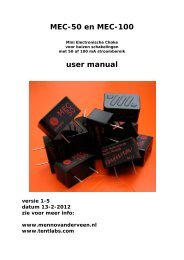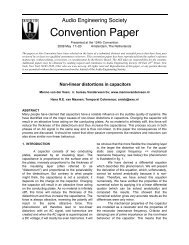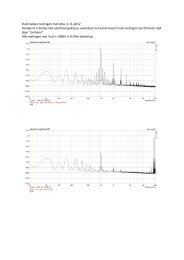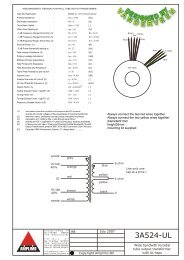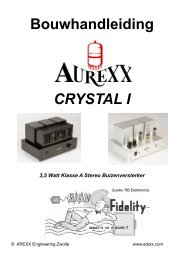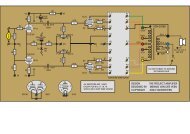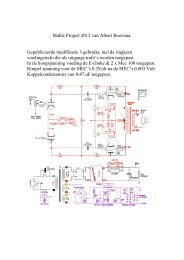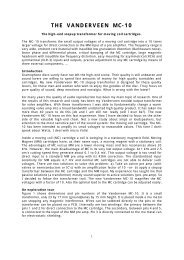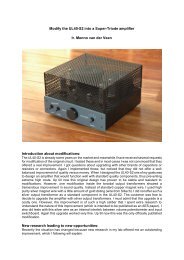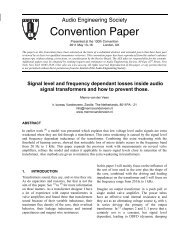MEC-manual-UK.pdf - Menno van der Veen
MEC-manual-UK.pdf - Menno van der Veen
MEC-manual-UK.pdf - Menno van der Veen
You also want an ePaper? Increase the reach of your titles
YUMPU automatically turns print PDFs into web optimized ePapers that Google loves.
5- Safety and helpful application remarks<br />
a) Hum reduction (measured up to 1 kHz) a factor of 1000 (<strong>MEC</strong>-50) and<br />
a factor of 250 (<strong>MEC</strong>-100)<br />
b) Voltage drop maximum 12 V (Mec-50) and 9 V (<strong>MEC</strong>-100)<br />
c) Use C1=C2=47 µF as optimal capacitors for the <strong>MEC</strong>-50<br />
Use C1=C2=100 µF as optimal capacitors for the <strong>MEC</strong>-100<br />
d) For smaller I, apply C1=C2=47*I/50 (µF, I in [mA], <strong>MEC</strong>-50)<br />
e) For smaller I, apply C1=C2=100*I/100 (µF, I in [mA], <strong>MEC</strong>-100).<br />
f) The <strong>MEC</strong>'s are designed for class A amplifiers with constant current<br />
demand. C-L-C oscillations as calculated with "PSU designer II) occur,<br />
however, they dampen much faster than calculated. If problematic, apply<br />
a series resistor.<br />
g) V in,max + ripple = 800 V DC . Charge C1,2 slowly at such high voltages, for<br />
instance by means of a rectifier valve which filament heats slowly.<br />
h) The <strong>MEC</strong>'s are not protected for shortcut outputs<br />
i) The <strong>MEC</strong>'s are protected for inversed connection. However, the hum<br />
reduction does not function then.<br />
j) The <strong>MEC</strong>'s are not designed as inductive anode load, nor for so called<br />
L-C application without C1, because the input voltage ripple should be<br />
rather small (< 10 Vpp) to stay inside the SOA of the <strong>MEC</strong>'s.<br />
6- Subjective observations<br />
Applying the <strong>MEC</strong>'s has a profound influence. Hum is absent, even with<br />
your ears close to the loudspeakers. The measurements show an<br />
impressive hum reduction over a wide frequency range. This largely<br />
reduces mains intermodulation interference with audio signals, and<br />
consequently the sound character is much friendlier. As an example, in<br />
the piano you now can hear and follow the sounds much longer and<br />
deeper. Without the <strong>MEC</strong> you were not able to hear down to such a micro<br />
detail level, as if a curtain was between you and the piano. The higher<br />
harmonic components of instrument tones are separately recognizable.<br />
Much more details can be heard, even the CD starts to sound mild,<br />
because no digital disturbance is found on the mains high voltage supply<br />
lines. The music sounds more dynamic with the <strong>MEC</strong>, even low tones<br />
sound stronger and better controlled.<br />
In summary: the sounds are cleaner and clearer, with much more natural<br />
warmth.



